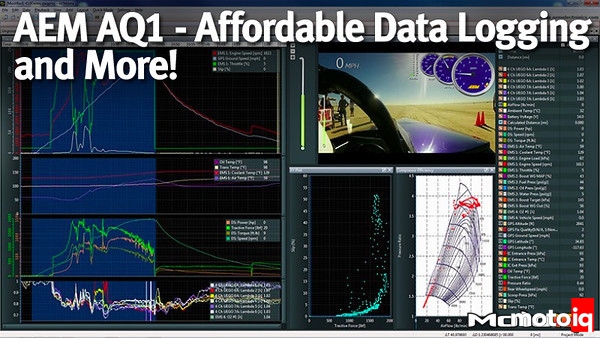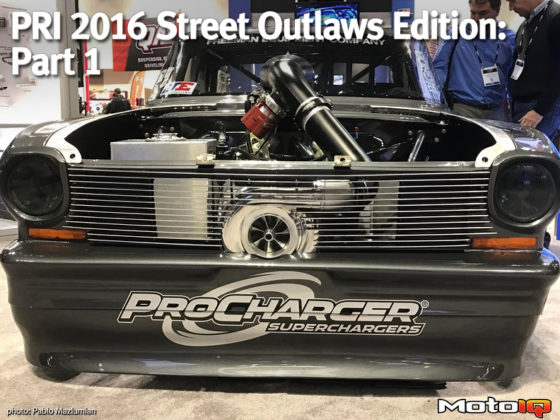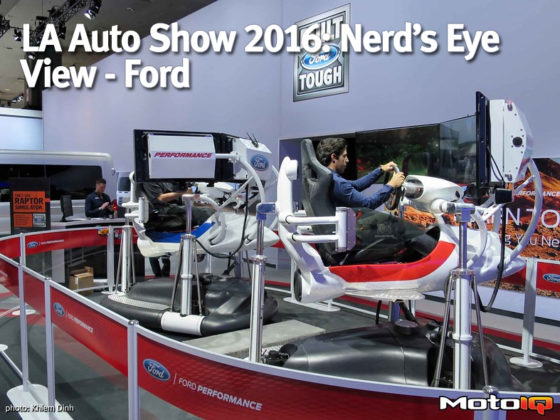
AEM AQ1 – Affordable Data Logging and More!
by Ramitha Edirisinghe
Henry Ford once said, “Auto racing began five minutes after the second car was built.” To which I add, “..and the importance of data was realized soon after the first race was lost.” Any racer knows that car setup is a key element to winning races, and the faster you can get to the optimal setup, the more of an advantage you have over your competitors. In the professional levels of motorsports, you will not find a single competitive team that does not utilize data logging of some sort. For these professional teams, data is used to drive all decisions: vehicle development, trackside setup, and driver performance evaluations. The teams that can utilize data most efficiently and develop their cars the quickest, are oftentimes the ones that win races time after time again.
While on-board data logging has been used by professional race teams for decades, it has been simply too expensive for the average grassroots racer to afford. Recently, however, AEM came out with an awesome entry level data logging unit aimed at the grassroots racer: the AQ1. With an MSRP of $395, the AQ1 packs a lot of great features at a very reasonable price.

Let's start with an overview and explanation of the basic features of the AQ1.
AEM AQ1 Features
- Logging Channels: 8 Analog, 3 Digital
- Logging Speed: up to 1,000 hz per channel
- Serial/GPS Connectability
- 3 Axis Accelerometer
- AEMnet Compatibility

Logging Channels: 8 Analog, 3 Switched Digital
A data logger collects data by reading the voltage signals from electrical sensors. The limit to how many sensors can be read is dictated by the number of logging channels you have available. The most basic AQ-1 setup is able to read eight analog sensors and three switched digital sensors. Although a recent update to its software will allow the AQ1 to pull 128 channels from the company's Infinity ECU via AEMnet, AEM's CAN-bus network, as well as log data from any X-Series Digital Gauges via an AEMnet connection. They also recently released a Vehicle Dynamics Module that marries a 3-axis accelerometer, 3-axis gyrometer and a GPS/GLONASS antenna in one unit that is able to connect to the AQ-1 via AEMnet. An OBDII version of the AQ-1 is anticipated soon, which will give you all of the inputs of a standard AQ-1 in addition to any data your car's OBDII stream transmits.
On the hardware side, the function of the data logger is to read the voltages outputted by the sensors it is hooked up to and store them. Typically, sensors have a minimum and maximum voltage range, which usually is around 0 to 5V.
A switched digital sensor can only output two states: either max voltage (the ON state) or min voltage (the OFF state). These tend to be very basic sensors that usually only have two wires. These are useful when you want to see when something turns on or off while the car is running. The table below shows examples of how you can use switched digital sensors in data logging.
Example Uses for Switched Digital Sensors | |
Sensor Type | Logging Use |
Brake Pedal Safety Switch | To see when the driver is pressing the brakes on a run |
Clutch Pedal Safety Switch | To see when the driver is up shifting or downshifting. |
Engine Fan Switch/ Coolant Switch | To see when the engine fan is turning on. Especially useful when you are dealing with engine cooling issues |
Nitrous Switch | To see when a nitrous system is armed or used. We don't use this in time attack, but definitely useful for the drifters and drag racers out there. |
Toggle Switch | The sky is the limit on this one, basically whenever you want to know if you remembered to turn on an important switch for a run. |
Momentary Push Button Switch | Like the toggle switch, there are many uses for this one. Basically when you are using a pushbutton switch to momentarily turn something on (like Nitrous) and you want to know when, and how long the switch was on during the run. |
Common Trait: All these digital sensors are switches, they can only tell you when something turns ON and OFF. | |




